|

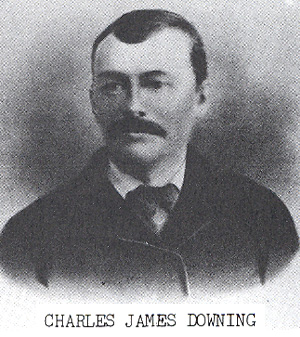 According to family
records, Charles James Downing was born December
15, 1859, in Canandaigua, Seneca Township,
Lenawee County, Michigan. His mother was Nancy
Getty. Nothing is known of his father except his
name, Charles Henry Downing, and that he lived
in New York. Countless efforts have been made to
obtain records from various counties in New York
and in Michigan which would give some insight
into the circumstances of Charles' birth. According to family
records, Charles James Downing was born December
15, 1859, in Canandaigua, Seneca Township,
Lenawee County, Michigan. His mother was Nancy
Getty. Nothing is known of his father except his
name, Charles Henry Downing, and that he lived
in New York. Countless efforts have been made to
obtain records from various counties in New York
and in Michigan which would give some insight
into the circumstances of Charles' birth.
All
inquiries have been answered in the negative
except one a military record from the Civil
War: "Charles H. Downing of Rochester, New York,
enlisted in the
Union Army on August 23, 1862,
in Co. D, 140th Regiment of New York. He fought
in the battles of Fredericksburg and
Chancellorsville, and was discharged on July 13,
1865, at Alexandria, Virginia. He died in
Rochester on March 24, 1874." It is believed
that he was the father of Charles James Downing,
but unfortunately there is no documentation to
prove it.
Charlie spent some years of
his boyhood in New York, then again when he was
a teenager, at which time he worked on the
railroad.
The following is from an
account written by Nora E. Downing Squires in
1964.
"Charles James Downing was
born in Canandaigua, Lenawee County, Michigan.
He spent his early boyhood at Elmira, New York
State, returning to Seneca, Michigan, a t the
age of ten years. At the age of eighteen years
he came to Ridgeway Township, Lenawee County,
Michigan. He farmed here the remainder of his
life.
Mother and Dad met while
they both worked at the Irving Osburn farm.
After a courtship of three
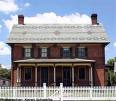 weeks, they were
married. They first settled on the J.F. Pilbeam
place for a short while and then purchased forty
acres on the comer of Lenawee County Line and
Kniffen Roads. They gradually expanded both
family and farm until they owned 400 acres and
had raised eleven children. weeks, they were
married. They first settled on the J.F. Pilbeam
place for a short while and then purchased forty
acres on the comer of Lenawee County Line and
Kniffen Roads. They gradually expanded both
family and farm until they owned 400 acres and
had raised eleven children.
Marion, my youngest
sister, was born in 1905 in the two story
building Dad built for us to live in while they
were building the big brick house which is now
occupied by Leland's family. To accommodate our
family, Dad included twelve rooms in the house.
The other building that Marion was born in was
then used as a granary. Dad's main love and
source of income was fattening cattle. One time
he bought 25 steers in Detroit and had Irv and
Charlie drive them all the way home, making it
in two days. They stayed the night on Michigan
Ave. with a family named Willinger. Dad met them
on the second day with old Pearl and the buggy."
Charlie was just nineteen
when he bought his first land on May 1, 1878. He
purchased twenty acres from his mother. It was
the north half of a forty acre parcel on the
County Line just north of where Leslie Downing
lives. Later that same year Nancy sold the south
half to her second son, Alonzo Titsworth, and
Alonzo in turn sold it to Charlie in 1887.
On the following page is
the marriage certificate of Charles Downing and
Estella Carman.
"This is to certify that Charles
J. Downing of Ridgeway Township, Michigan and
Estella Carman of Ridgeway Township, Michigan,
were united in Marriage according to the
Ordinance of GOD and the Laws of the State of
Michigan at East Ridgeway on the 24th day of
February in the year of OUR LORD One Thousand
Eight Hundred and eighty three." B. F. Rapp,
Minister of the Gospel
Witnesses: Lettitia Rapp
and Mary Grace Rapp
Estella was the daughter of
Lewis Major Carman and Mary Christina Mourison
of Petersburg, Michigan, formerly of Morris
County, New Jersey. The Cannans and Mourisons
were two of the older families of New Jersey,
their ancestors having fought in the
Revolutionary War and the War of 1812. Their
story will be printed at a later date.
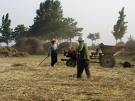 Charlie and Estella set up
housekeeping on the Ireland farm north of
Deerfield. They were tenant fanners for Irving
Osburn. They then lived for a time on their farm
on the County Line, which was to become Harry
Downing's place later. On November 2), 1896,
they bought the old George K. Getty homestead
from Thomas VanDuzer, where Albert Wielfaert now
lives, and lived there for a few years. Charlie and Estella set up
housekeeping on the Ireland farm north of
Deerfield. They were tenant fanners for Irving
Osburn. They then lived for a time on their farm
on the County Line, which was to become Harry
Downing's place later. On November 2), 1896,
they bought the old George K. Getty homestead
from Thomas VanDuzer, where Albert Wielfaert now
lives, and lived there for a few years.
Charlie thought so much of
his Grandpa Getty, and always spoke highly of
him. It was his dream to one day
make his home on his Grandpa's homestead. George
K. Getty had acquired the James Getty property
shortly before James died. He sold it to James
Curry and, I believe, Curry sold it to Beecher
Lighthall. Charlie bought the 40 acre homestead
from Lighthall on August JO, 1904. Over the
years he bought more acreage on both sides of
the homestead, as well as additional land
adjoining the old George K. Getty farm,
extending to the land he owned on the County
Line.
In preparation for moving
to the homestead, Charlie built a two story
building which was as nice as any house even had
matched flooring of solid oak. The family lived there
while the large brick house was being built. It
was later used for a granary, and still stands
behind the house. The old log cabin which James
Getty built was drawn down back by the creek and
the logs were burned. The new brick home was
built on the same site where the log cabin had
stood. All the bricks were hauled from Azalia
and Maybee and the lumber from Kohler's Lumber
Yard in Petersburg. Anna, Charlie's oldest
daughter, baked fresh bread every day for the
carpenters and masons.
 The workers were careful
not to disturb the pear tree which James Getty
had planted many years before, and the stump is
still standing in front of the house today. The
tree was badly damaged by a storm a few years
ago and had to be cut down. However some shoots
grew up from the roots and bore a few of the Gleckley pears, sweet as ever. The new well was
put down and the windmill erected just north of
where James' original well was. Charlie
Downing's homestead was one of the show places
of northeastern Lenawee County. The workers were careful
not to disturb the pear tree which James Getty
had planted many years before, and the stump is
still standing in front of the house today. The
tree was badly damaged by a storm a few years
ago and had to be cut down. However some shoots
grew up from the roots and bore a few of the Gleckley pears, sweet as ever. The new well was
put down and the windmill erected just north of
where James' original well was. Charlie
Downing's homestead was one of the show places
of northeastern Lenawee County.
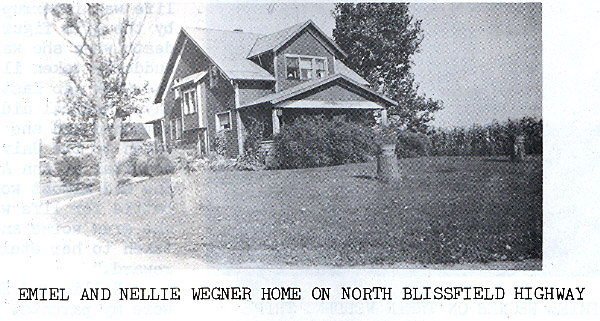
A small country church of
frame construction stood on the southeast corner
of Milwaukee Road and Shaw Highway. It was
called the DeSpelder Church, named for the first
minister, Rev. DeSpelder. Even though it was of
the Presbyterian denomination, it was served
from time to time by ministers of other faiths.
The Gettys and the Downings, as well as most of
their Irish neighbors attended this church.
The
Ladies Aid Society prepared home cooked dinners
periodically, and even all the school kids, at
lunch hour, had a chance to go and partake of
the delicious food. It has been said that when
Nub Getty was moving his threshing rig from one farm to another
that sparks from the
 steam engine ignited the
long horse and buggy shed on the church lot,
completely destroying the shed as well as the
church. Soon after the fire, another church was
built of bricks. However, in years to come, the
congregation dwindled to such a small number of
members, and eventually disbanded. The building
was torn down and removed. Early this century
there was another small church on Pennington
Road, across from Irv Downing's farm. Old Mrs.
Charlie East had donated the land on which it
was erected. It was a zealous little Free
Methodist Church. steam engine ignited the
long horse and buggy shed on the church lot,
completely destroying the shed as well as the
church. Soon after the fire, another church was
built of bricks. However, in years to come, the
congregation dwindled to such a small number of
members, and eventually disbanded. The building
was torn down and removed. Early this century
there was another small church on Pennington
Road, across from Irv Downing's farm. Old Mrs.
Charlie East had donated the land on which it
was erected. It was a zealous little Free
Methodist Church.
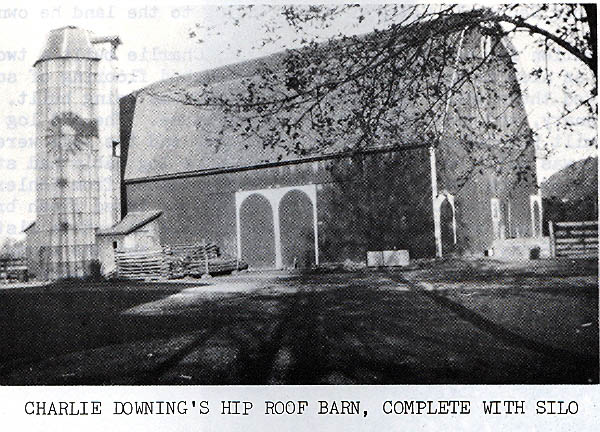
Charles and Estella had
eleven children.
-
Irving Henry (1881 to 1956)
married Ella Hazel Frost.
-
Anna Matilda
(1886 to 1919) married Charles Anspach.
-
Nora Belle
(1887 to 1973) married Ransom Earl Squires.
-
Charles
Clayton (1889 to 1962) married Camilla Jane Wilson.
-
Joseph Emery (1891 to 1972) married Iva Elizabeth
Spencer.
-
Martha Ellen "Nellie" (1893
to 1929)
married Emiel Wegner.
-
Louis Ezra (1895 to 1954)
married Mary C. Williams.
-
Walter Harry
(1897 to 1976) married (1) Vera Mae Grant, (2)
Helen Craig Pierce.
-
Leland George (1901 to 1971)
married Fannie Ellen Wadsworth.
-
Leon James
(1901 to 1903) was Leland's twin. He died of
indigestion and whooping cough when he was less
than two years old.
-
Marion Estelle (1905 to 1977)
married Fenton Lafayette Barrett.
During the days when
Corlie's children were young, they didn't have
to go away from home to have fun, especially
where there were large families. They provided
their own entertainment. As soon as they were
big enough the boys did the chores and helped
with the work in the fields, and the girls
helped with the housework. After the day's work
was finished, there was always plenty of leisure
time for games and reading.
Before this area was
settled, Indian tribes used to camp on ground
which was now part of Charlie's farm. The boys
found lots of arrowheads and other stone
artifacts out back on the hill and, also, in the
garden.

Threshing season started in
July and lasted for several days, until all the
wheat and oats in the neighborhood had been
threshed. It was a busy and exciting time for
everyone. Sometimes the boys got to tend the
blower of the separator (or threshing machine)
which blew the separated straw into a stack like
the one pictured on the
 previous page in the
barnyard behind the barn. It was fun to play on
the straw stack, but you better not get caught
because the folks considered it too dangerous.
The older boys usually had to drive the wagons
through the fields of shocked grain, while the
men pitched the bundles up onto the wagon.
Another man, with a pitch fork, always stood on
top of the wagon so he could load the bundles
evenly. The loaded wagons, coming up from the
field, would pull into the yard and line up by the
threshing machine. As the bundles of grain were
fed into the separator, the separated kernels of
grain came out of a chute into bags which men
then carried on their shoulders to the granary,
where it was dumped into the clean bins. Or
sometimes the chute emptied directly into
barrels, as pictured above, and they were hauled
to the granary in a wagon. previous page in the
barnyard behind the barn. It was fun to play on
the straw stack, but you better not get caught
because the folks considered it too dangerous.
The older boys usually had to drive the wagons
through the fields of shocked grain, while the
men pitched the bundles up onto the wagon.
Another man, with a pitch fork, always stood on
top of the wagon so he could load the bundles
evenly. The loaded wagons, coming up from the
field, would pull into the yard and line up by the
threshing machine. As the bundles of grain were
fed into the separator, the separated kernels of
grain came out of a chute into bags which men
then carried on their shoulders to the granary,
where it was dumped into the clean bins. Or
sometimes the chute emptied directly into
barrels, as pictured above, and they were hauled
to the granary in a wagon.
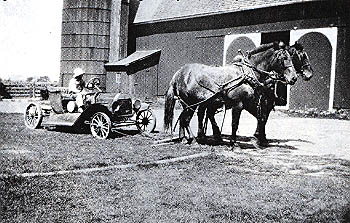
Through perseverance,
ambition and excellent planning, Charles and
Estella acquired a great deal of material
wealth, especially land, of which they owned at
one time close to a full section. In later years
the road running past the homestead was named
Downing Highway, at the suggestion of Leland's
wife, Fannie. The road had been named Putnam,
for a school teacher in Britton. But this man
had long since moved back to Ohio.
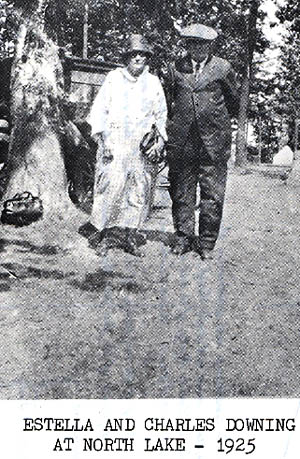 Charlie and Stel were both
well liked in the community, being friendly,
thoughtful and neighborly. Charlie was also very
kind to his mother, Nancy. Nancy lived in a
small house in Britton, which Charlie and Lon
had bought for her. She had no income, so
Charlie paid the taxes, brought firewood for her
stove, and saw to it there were always groceries
in the house. Charlie and Stel were both
well liked in the community, being friendly,
thoughtful and neighborly. Charlie was also very
kind to his mother, Nancy. Nancy lived in a
small house in Britton, which Charlie and Lon
had bought for her. She had no income, so
Charlie paid the taxes, brought firewood for her
stove, and saw to it there were always groceries
in the house.
They worked hard from
daylight to dark, but managed to retain their
sense of humor. They helped their sons get set
up on farms and also helped their daughters as
much as they could.
Charlie and Stel’s oldest
child, Irving Henry Downing, was born April 25,
1884. On June 10, 1909, he married Ella Hazel
Frost. They set up housekeeping in a little old
house on a farm which his dad owned near Curry's
Comers. After living there a short time, they
moved onto a 120 acre farm on Pennington Road
near the intersection of County Line, across
from a little country church. They had three
daughters: Beatrice Irene, Estella Marie and
Rena Mae. The year that Stella was born, 1917,
Irv built a new house for the family.
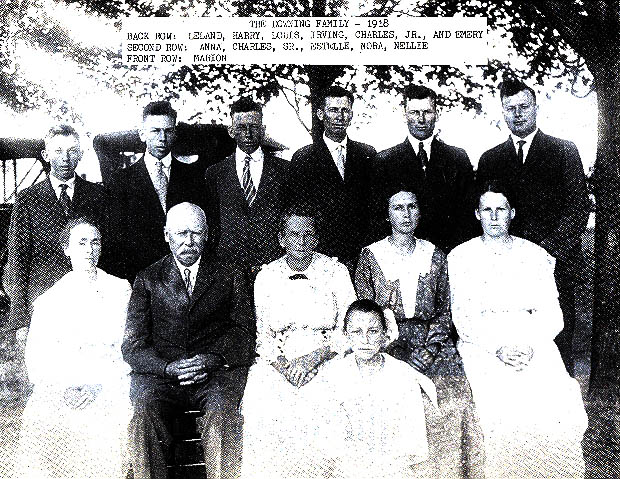
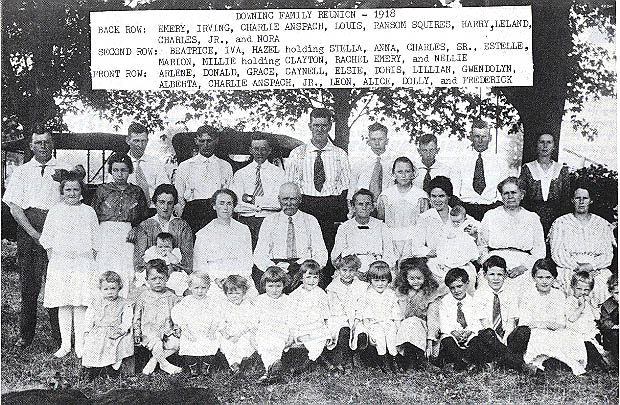
Irv died June 25, 1956, at
the age of 72 years of arteriole sclerotic heart
disease. Hazel continued to live on the farm
until she married Alva Myers. Since Alva's death
she has been living with Beatrice and is now 95
years old.
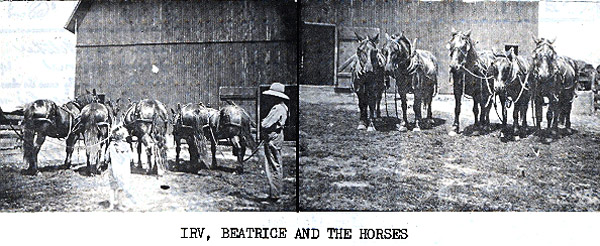
Anna Matilda was born
January 13, 1886. She married a man from Detroit
named Charles Henry Anspach, who had a son,
Charles, Jr. Charles and Anna's first born,
LeRoy David, was born May 10, 1914, but lived
less than three months. He died on August 1,
1914, with spinal meningitis.
After their daughter, Grace
Laura, was born, Charles quit his job in
Detroit, and since all the Downings were
prosperous farmers, he felt obligated to try his
hand at making their living off the
 land, too.
They lived on several different farms in the
Ridgeway area, but he finally realized he was no
farmer, so he gave up that occupation. When she
was only 32 years old, Anna developed cancer.
She thought it was the result of an accident she
had some years before, where she was thrown out
of a buggy. During Anna's last weeks, Estella
took care of her in their home. It was at this
time that Fannie Wadsworth of Petersburg came to
work for the Downings, and this was of course
where she met Leland. On December 10, 1919, at
the age of 33 years, 1 month, and 3 days, Anna
succumbed to the dread disease. land, too.
They lived on several different farms in the
Ridgeway area, but he finally realized he was no
farmer, so he gave up that occupation. When she
was only 32 years old, Anna developed cancer.
She thought it was the result of an accident she
had some years before, where she was thrown out
of a buggy. During Anna's last weeks, Estella
took care of her in their home. It was at this
time that Fannie Wadsworth of Petersburg came to
work for the Downings, and this was of course
where she met Leland. On December 10, 1919, at
the age of 33 years, 1 month, and 3 days, Anna
succumbed to the dread disease.
Nora Belle was born October
16, 1887. She graduated in 1905, in the first
class which graduated from Britton High School.
The class is pictured on the previous page. She
met Ransom Squires at a card party, and they
were married November 26, 1908.
Nora and Ransom started
housekeeping on the old Dan McFall place On Cone
Road, and in 1915 they bought the Fred Greener
farm on the east side of North County Line, just
south of the Pennington Road intersection. It
was here On their farm that they raised their
four children: Alice Estelle, Leon Jerome, Elsie
Genevieve and Ransom Earl, Jr. Ransom died July
16, 1961, and Nora passed away on February 26,
1973.
 Charles Clayton was born
August 26, 1889. He was the fourth of eleven
children, and with his family, grew up in the
Downing Highway County Line area. As was the
case with all farmer's children, he and his
brothers helped their father with whatever was
to be done clearing and working the land,
planting and harvesting the crops, building and
maintaining the dwelling as well as the barns,
granaries, corn cribs, and hen houses. In
1904 and 1905, he and Irv hauled all the bricks from Azalia and Maybee to build the big brick house
on Downing Highway. Charles Clayton was born
August 26, 1889. He was the fourth of eleven
children, and with his family, grew up in the
Downing Highway County Line area. As was the
case with all farmer's children, he and his
brothers helped their father with whatever was
to be done clearing and working the land,
planting and harvesting the crops, building and
maintaining the dwelling as well as the barns,
granaries, corn cribs, and hen houses. In
1904 and 1905, he and Irv hauled all the bricks from Azalia and Maybee to build the big brick house
on Downing Highway.
On December 6, 1911, he
married a school teacher named Camilla Jane
Wilson.
Camilla was born December
28, 1889, and was always called "Millie".
Charles was nicknamed "Chuck".
They set up housekeeping in
an old log house where his mother and father had
lived several years before. They lived here
until their new house was completed on the east
side of the Monroe Lenawee County Line. This is
where Thelma Henning lives now. Here they made
their home until 1921, when they moved across
the road to another new house where Robert and
Bonnie Downing now reside.
 Chuck was a farmer all his
life, starting out on forty acres. During his
lifetime he was able to accumulate 260 acres.
Much of this land had to be cleared. From his
early training with his father and brothers, he
had become quite an accomplished carpenter. He
built two houses, the outbuildings, and in later
years two cottages at Portage Lake. Neighbors
and friends for miles around helped in the "barn
raising" during the summer of 1926, when his big
hip roofed bam was built. Chuck was a farmer all his
life, starting out on forty acres. During his
lifetime he was able to accumulate 260 acres.
Much of this land had to be cleared. From his
early training with his father and brothers, he
had become quite an accomplished carpenter. He
built two houses, the outbuildings, and in later
years two cottages at Portage Lake. Neighbors
and friends for miles around helped in the "barn
raising" during the summer of 1926, when his big
hip roofed bam was built.
Chuck and Millie had eight children:
-
Doris Ann
-
Gwendolyn Floy
-
Mary Gaynell
-
Clayton Alfred
-
Betty Jane
-
Lewis Charles
-
Leslie James
-
Joan Carol
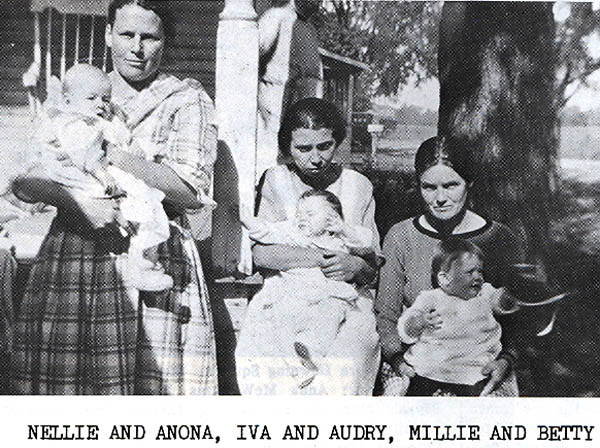
Chuck
served as treasurer of the Getty School for many
years. He was instrumental in getting Detroit
Edison to extend electrical service to the
community. They were considered a progressive
couple in the neighborhood. In later years, they
both enjoyed traveling and spent many happy days
at their cottage at Portage Lake.
Millie died at the age of
65 of metastic carcinoma, On March 6, 1955.
Chuck died October 26, 1962, age 73, of
broncogenic cancer with metastasis.
Joseph Emery was born
September 12, 1891. He married Iva Elizabeth
Spencer, daughter of Fred Simeon and Alice
Kriedler Spencer. Their first home after they
were married was a log cabin on the second 40
acres south of Downing Highway on the County
Line (where Geigler lives now), and they had
their first child, Donald, while living there.
Helen Arlene was born in the big two story brick
house just east of the County Line on Milwaukee
Road, where they were tenant farmers.
At the time when the
cyclone went through on the Ridge, in 1920, they
were living in an old house at the end of a lane
on County Line north of Welch Road. They watched
the cyclone as it passed. Shortly afterwards
they bought a farm on the east side of North
County Line, a short distance south of Nora and
Ransom’s farm. They spent the rest of their
lives here.
Emery and Iva had six
children: Donald Charles, Helen Arlene, Audrey
Louella, Charlotte Leone, Dean Spencer, and
Shirley Ann. Iva died from injuries received in
an auto accident on August 29, 1955. Emery
(called "Bun") continued to live on the farm,
well known in later years for the great number
of prime hogs which he raised. He died May 8,
1972.
Martha Ellen "Nellie"
Downing was born August 2), 189). She married
Emiel Wegner in Ontario when she was only 17 on
September 2), 1910. Emiel was a son of C. F.
Wegner of Wellsville, whose family had emigrated
from Germany in 188). They settled on a forty
acre farm just south of Immanuel Lutheran Church
on North Blissfield Highway, in the area known
as "Dutchtown".
Nellie and Emiel had ten
living children: Alberta Louella, Lillian Opa,
Frederick Charles, Mathilda Estelle, Marvin
Emiel, Melvin Louis, Anona Rachel, Georgiana
Marie, Josephine Marion and Monita Madeline.
 On August 28, 1929, when
Nellie was 6 years old, she died in the
University Hospital, Ann Arbor, in childbirth
(with the eleventh child a son). A few lines
from her obituary follow: "Together with her
husband she made her home in Palmyra Twp. at the
home where the fatal illness overtook her and
here their hopes and joys centered on their farm
home and the family God gave to them. In later
years she also embraced the faith of her husband
and was baptized into the Christian faith after
she had familiarized herself with its doctrines.
So she and her husband lived happily together,
she rendering him a loving helpfulness of a
faithful wife, caring for her children and her
home. On August 28, 1929, when
Nellie was 6 years old, she died in the
University Hospital, Ann Arbor, in childbirth
(with the eleventh child a son). A few lines
from her obituary follow: "Together with her
husband she made her home in Palmyra Twp. at the
home where the fatal illness overtook her and
here their hopes and joys centered on their farm
home and the family God gave to them. In later
years she also embraced the faith of her husband
and was baptized into the Christian faith after
she had familiarized herself with its doctrines.
So she and her husband lived happily together,
she rendering him a loving helpfulness of a
faithful wife, caring for her children and her
home.
In an entirely unforeseen
manner this home life was interrupted by the
grim figure of death when she was suddenly taken
ill one week o last Monday. Medical aid was
summoned and she was taken to the University
Hospital at Ann Arbor. She had almost won the
battle for life when she grew worse and was
taken to her eternal reward."
Nellie and Emiel were my
parents.
Following is an excerpt
from a letter written by Emiel to his oldest
daughter, Alberta, in 1963.
 |
|
"…but think 80 years ago
when ma an pa come to this country no money no
place to live no job, but a big family and kept
on getting bigger all the time. Just look at the
difference in the last 50 years, when your Ma
and I were married. I had $150 to run us till
the next spring, the winter after we were
married chuck (Chuck Downing) & I cut wood all
winter for 6o¢ to 65¢ a cord the most we could
cut in one day was 3 to 5 cord a day.
The next
spring we moved in that old house, then I had to
buy one horse and plow, but then we were still
happy. Then I don carpenter work with your uncle
Bill Prilipp building barns turn that boring
machine 10 hours day four $2 but they were still
happy. I think it was in 1913 we build the barn.
Then in 1917 we built the house. Them were still
happy days but we were still poor. " |
|
 |
Emiel went through the
third grade at English school. He was then taken
out of school and was sent to German school at
the church, taught by the minister in German.
This was the case with all the children of the
neighborhood which was primarily a German
settlement. The duration of German school was
usually four years, with the preachers being
strict disciplinarians. The taskmasters were so
strict that sometimes they would whip the
children unmercifully. However, as the years
went by, each succeeding minister proved to be a
little more lenient.
In 1931 Emiel married
Aurila Shipley. After 27 years together they
were divorced. In 1959 he married Irene Bachtal.
They had two children; Susan and Debra. Emiel
died October 27, 1966.
Louis Ezra was born
November 13, 1895. In 1913 he was accidentally
shot in the hip while hunting crows with a
couple of neighbor boys. In 1918 he was drafted
into the army. He took his
 training at Camp
Custer. After World War I, he worked for farmers
in the neighborhood. He married Mary C.
Williams, and they had four children: Russell
James, Anna Ruth, Katherine Eudora and Roland
Louis. Lou never owned a farm. He went to work
for Ford Farms and he and his family lived on
various farms in the Macon area. Later in life
they moved to Britton and he worked several
years for the Tecumseh Products as a guard. Lou
died February 25, 1954, age 58; cause of death
coronary occlusion. training at Camp
Custer. After World War I, he worked for farmers
in the neighborhood. He married Mary C.
Williams, and they had four children: Russell
James, Anna Ruth, Katherine Eudora and Roland
Louis. Lou never owned a farm. He went to work
for Ford Farms and he and his family lived on
various farms in the Macon area. Later in life
they moved to Britton and he worked several
years for the Tecumseh Products as a guard. Lou
died February 25, 1954, age 58; cause of death
coronary occlusion.
Walter Harry was born
August 23, 1897. He married Vera Mae Grant on
January 1, 1919, and they had a farm on the west
side of County Line where Geiglers live. For a
short time Harry traded places with his dad.
Charlie had built a brand new house on the farm
on the County Line and he and Stel moved there.
Harry and Vera moved onto the homestead, where
Dorothy Jean was born in 1919. Around 1921 they
switched back, after which Harry sold the farm
and went to work for the Ford Farms at Macon.
They had three more children: Duane Grant (died at birth), Lois
Emma and Merlyn Harold. Vera died January 21,
1929. Merlyn was less than two years old. He
went to live with Leland and Fannie and was
raised as their own son. Harry married Helen
Craig Pierce June 11, 1932, and
 later in life
they built a new house in Britton. Harry retired
in 1960 from the maintenance department at Ford
Motor Company in Rawsonville. He died at the age
of 78 years on May 3, 1976. Helen died July 4,
1985. later in life
they built a new house in Britton. Harry retired
in 1960 from the maintenance department at Ford
Motor Company in Rawsonville. He died at the age
of 78 years on May 3, 1976. Helen died July 4,
1985.
Leland George and Leon
James, twins, were born July 1, 1901. On April
4, 1903, Leon died of indigestion and whooping
cough. Leland married Fannie Wadsworth of
Petersburg on June 1, 1926. About this time,
Charlie and Stel moved into a small frame house
on a farm they owned on Kniffen Road, the old
Tuttle Place. Leland and Fannie moved into the
big brick house and took over the homestead.
They had one daughter, Madelyn Eunice. After
Vera died, Merlyn came to live with them, and
they brought him up as their own son. Leland
farmed the homestead until his death, April 6,
1971. Fannie taught school for many years, and
since her retirement, she has continued to live
in the big brick house.
Marion Estelle was born
October 5, 1905. On June 2, 1931, she married
Fenton "Bob" Lafayette Barrett, son of Edward
and Maggie (Rockwood) Barrett. They had two
children: Charles E. and Margaret Estelle.
Marion taught school for forty years until her
retirement in 1967. They made their home with
Charlie and Estelle on the farm on Kniffen Road.
Bob died September 21, 1975, and Marion on
December 21, 1977.
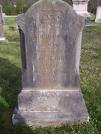 Charlie Downing died of a
stroke of apoplexy at his home on April 11,
1932, age 72; cause of death arterial sclerosis,
chronic nephritis, and cerebral hemorrhage.
Estella died of cardio respiratory failure July
21, 19.50, age 88 years. They are both buried in
the, Ridgeway Cemetery. Charlie Downing died of a
stroke of apoplexy at his home on April 11,
1932, age 72; cause of death arterial sclerosis,
chronic nephritis, and cerebral hemorrhage.
Estella died of cardio respiratory failure July
21, 19.50, age 88 years. They are both buried in
the, Ridgeway Cemetery.
Charlie and Estelle were my
grandparents.
|